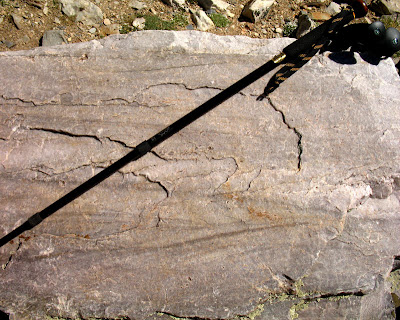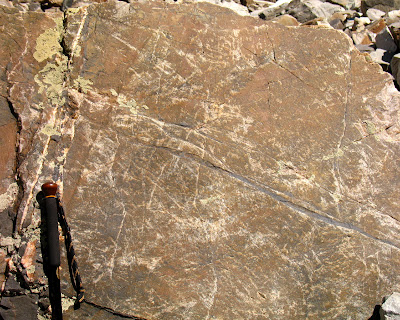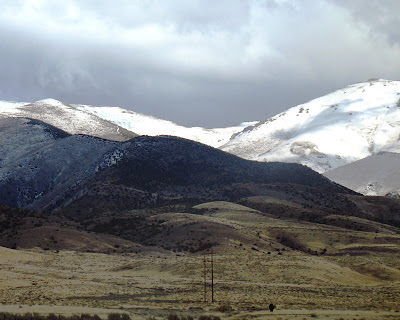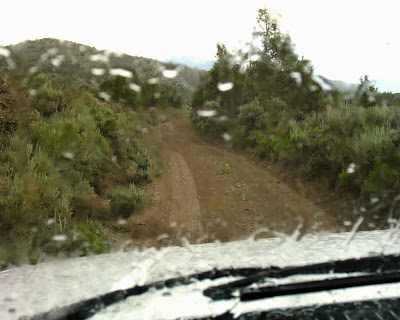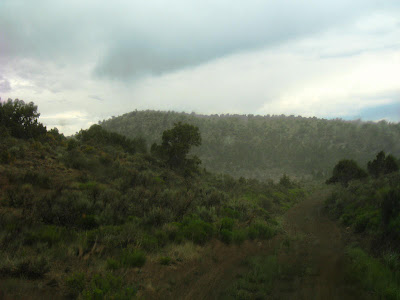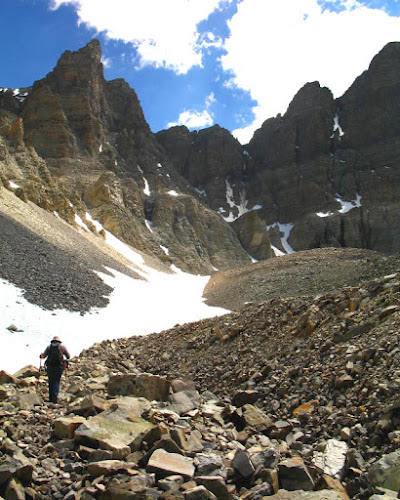As part of this
ongoing rock glacier series, I thought I'd get into the history of the rock glacier a little bit, as it cannot be found anywhere online in any detail. Most of this information comes from Osborne and Bevis, 2001 (OB2001). I'll have some more photos later, including an aerial view from the peak!
According to OB2001, it was W. Eimbeck who first wrote about the glacier in 1883, with his writing then being reported on by I. C. Russell (1885). Osborn and Bevis go on to assert that W. F. Heald then rediscovered the glacier in 1955 (reported on by Heald, 1956), although Heald said that he didn't rediscover it, he discovered it. His discovery or re-discovery, depending on which account is accurate, was described in
Desert Magazine in August, 1956, page 4, as follows:
Interest in [the Wheeler Peak] area as a potential national park developed in recent months after Weldon Heald of Tucson and Albert Marshall of Three Rivers, California, made the ascent of 13,061-foot [13,063] Wheeler Peak and ascertained that a glacier on the east slope of the mountain, first reported by the U. S.Geological Survey in 1883, was still active.... Following his ascent of Wheeler Peak, Weldon Heald wrote: "We arrived at the summit at noon. The view from the wedge-shaped crest of the Peak is utterly magnificent. From our perch on the topmost rocks, 13,061 feet above sea level, we looked out over a 360-degree panorama embracing thousands of square miles of deserts, valleys, hills and mountains in eastern Nevada and western Utah. Then we worked our way down the east slope to the edge of a 2000-foot sheer cliff. There in the depths of a cirque below we saw the ice field described by the Geological Survey in 1888. The surface was broken by what appeared to be a bergshrund, a secondary bergshrund [sic], and below these five parallel crevasses one above another. Every sign indicated that the ice was in motion and this was probably a true glacier."
And this is what Weldon F. Heald had to say about that, in the
October issue of Desert Magazine, pages 31-32:
Received my August Desert today and feel you did a mighty fine job of presenting the subject of the proposed park or monument in the Wheeler Peak area—and Norton Allen made a fine map from my rough one. I think this will help the cause along greatly. There's one thing though that seems to be misunderstood. The glacier was not "re-discovered" in 1955, it was discovered. Although Eimbeck saw ice at the head of the cirque in 1883, he neither reported it as an active glacier nor suspected it was one. The reason is rather easy to explain. He did not see into the bottom of the cirque, where the glacier lies, and it is probable he would not have realized that the ice was active because it was covered with too much snow.
The ice Eimbeck saw and reported, and pictured in his engraving, is the neve tongue on the cliffs above the glacier. Many must have seen this upper ice but no one suspected that an active glacier lay in the hidden cirque beneath. We wouldn't have either except that I especially chose September of one of the driest years on record, when all the usual snow had melted away and left the naked ice beneath.
Old-timers tell me that a glacier has been supposed to exist on Wheeler Peak for years. However, it apparently was not this one but an ice field in Wheeler Peak's south cirque. We saw this too, but it is now greatly shrunken and definitely not active. So, inasmuch as no one knew or suspected that a glacier existed in Wheeler Peak's north cirque until 1955, I feel that it was definitely discovered then, and that we discovered it, not Eimbeck. However, it was his tip that made me scout for the ice — but I never had any idea I'd find an active glacier.
Others who wrote about the glacier after 1956 - as cited by OB2001 - include Lawrence (1958), Kramer (1962), Currey (1969), Waite (1974), and Osborn (1990). Some confusion apparently existed as to what to call the glacier and the rock glacier, with the glacier being referred to as follows (again from OB2001):
- 'body of ice...that approaches the condition of a glacier'
- 'glacieret'
- 'ice mass'
- 'active glacier'
- 'ice field'
The rock glacier has been called by the following epithets, according to them:
- 'moraine tongue'
- 'mound of unstable moraine'
- 'rock deposit'
- 'rock glacier'
Various claims have been tossed around as to the active v. inactive status of both the glacier and the rock glacier, with the rock glacier sometimes being referred to as active and the glacier being called inactive to non-existent (the latter notably in an argument against the establishment of a National Monument or Park at Wheeler Peak - as per information from OB2001). It's the glacier that is (or has very recently been) active; it's the rock glacier that's inactive.
That most definitive paper I could find (OB2001) states that the glacier was active at the time of study, and that the rock glacier was not active (the study took place during the 1990's). They state that the "glacier grades into an ice-cored rock glacier downstream" - that would be down hill or down the ice gradient (or water gradient, if the thing is melting). And for various reasons - including topography, shape, vegetation, and presence or lack of certain tephra layers including ash from Mono Craters and Mt. Mazama - they determined that the upper portion of the rock glacier had an origin in the Little Ice Age (sometime from A.D. 1300 to A.D. 1850), and that the lower, lumpy part of the rock glacier had an origin sometime prior to A.D. 1200. Osborn and Bevis (2001) say "...shards of Mono Craters origin incorporated into the matrix of the lower rock glacier indicates a pre-1200 AD origin of that segment." This seems a bit confusing to me, because elsewhere in the paper, when refering to tephra from Mono Craters, they refer to the Mono Craters tephra that is dated at 1200 B.P. (not one from 1200 A.D.). So, I'm not sure what this means exactly, or maybe it has something to do with whether or not the C-14 dates are calibrated. There are numerous tephra layers from Mono Craters, with ages of 560 ± 20, 1200 ± 40, 2060 ± 75, 3730 ± 60, 7270 ± 70, 8235 ± 105, and 9710 ± 80 B.P. (dates from this site; calibrated or not?).
Because the Mazama ash doesn't occur anywhere in the southern Snake Range, according to Osborn and Bevis (2001), I presume that its absence in or on the rock glacier can't be used to determine whether the rock glacier is older or younger than the 6845 ± 50 B.P. carbon-14 date on the Mazama ash, or about 7,700 calendar years ago (Bacon, 1983). According to a map showing the distribution of the Mazama ash, by Sarna-Wojcicki, Champion, and Davis (1983) [per OB2001], the southern Snake Range may be right near the edge of the fallout lobe of the Mazama ash. I found two maps online; one is from Sarna-Wojckicki and Davis (1991), [published posthumously by J. O. Davis]; the other one has an undefined origin, but might be from S-W, C, and D (1983). The latter map is more detailed.
The bottom line is: active glacier (unless it has become inactive during the last decade) and inactive, ice-cored rock glacier.
Rock Glacier Definitions:
USGS Glossary of Glacier Terminology
USGS Rock Glaciers
J. Geophysical Research
References:
Bacon, C. R., 1983, Eruptive History of Mount Mazama and Crater Lake Caldera, Cascade Range, U.S.A.: Journal of Volcanology and Geothermal Research, v.18, p.57-115.
Currey, D.R., 1969. Neoglaciation in the mountains of the southwestern United States. Unpublished Ph.D. Thesis, University of Kansas.
Heald, W. F., 1956, An Active Glacier in Nevada: American Alpine Journal, 10 (1), 164-167.
Kramer, F.L., 1962. Rivers of stone. Pacific Discovery 15 (5), 11-15.
Krimmel, R.M., 2002, Glaciers of the western United States, with a section on Glacier retreat in Glacier National Park, Montana by Key, C.H., Fagre, D.B., and Menicke, R.K.,
Glaciers of the conterminous United States (J-2)
in in Williams, R.S., Jr., and Ferrigno, J.G., eds., Satellite image atlas of glaciers of the world:
U.S. Geological Survey Professional Paper 1386-J (Glaciers of North America), 405 p., ISBN 0-067-98290-X.
Lawrence, E., 1958. The Wheeler Glacieret of the Wheeler Peak area, White Pine County, Nevada. Unpublished manuscript, Nevada Bureau of Mines, Reno.
Meier, M.F., 1961, Distribution and variations of glaciers in the United States exclusive of Alaska, in General Assembly of Helsinki, 1960: International Association of Scientific Hydrology Publication No. 54, p. 420–429.
Osborn, G., 1990. The Wheeler Peak cirque and glacier/rock glacier. Unpublished report prepared for the Great Basin Natural History Association. University of Calgary Dept. of Geology and Geophysics.
Osborn, G. and Bevis, K., 2001,
Glaciation in the Great Basin of the Western United States: : Quaternary Science Reviews 20, 1377-1410.
Russell, I.C., 1885. Geological history of Lake Lahontan, a Quaternary lake of northwestern Nevada. U. S. Geological Survey Monograph 11, 288.
Sarna-Wojcicki, A. M., and Davis, J. O., 1991, Quaternary tephrocrhonology,
in Morrison, R. B. (ed.) Quaternary Non-Glacial Geology: Conterminous United States. Geological Society of America, Decade of North American Geology, Vol. K-2, Boulder, Colorado, 93-116.
Sarna-Wojcicki, A. M., Champion, D. E, and Davis, J. O., 1983. Holocene volcanism in the conterminous United States and the role of silicic volcanic ash layers in correlation of latest-Pleistocene and Holocene deposits. In: Wright Jr., H. (Ed.), Late Quaternary Environments of the United States 2. University of Minnesota Press, Mineapolis, pp. 52-77.
Waite, R., 1974. The proposed Great Basin National Park: A geographical interpretation of the southern Snake Range, Nevada. Unpublished Ph.D. Thesis, University of California at Los Angeles Geography Dept.
 On Highway 50 looking west, with the Huck Salt Road turnoff just behind that little hill sticking south into the playa.
On Highway 50 looking west, with the Huck Salt Road turnoff just behind that little hill sticking south into the playa.
 ...and a sign at the turnoff to Sand Mountain on the east side of Fourmile Flat.
...and a sign at the turnoff to Sand Mountain on the east side of Fourmile Flat.


 The three photos above show closer views of the pink to red to orange salt on the south side of Highway 50.
The three photos above show closer views of the pink to red to orange salt on the south side of Highway 50.
 And two more views, above, one showing some actual water. In my experience, the pinkish salt does not occur year-round. It appears to need the right combination of water and evaporation, and possibly the right temperature.
And two more views, above, one showing some actual water. In my experience, the pinkish salt does not occur year-round. It appears to need the right combination of water and evaporation, and possibly the right temperature.













